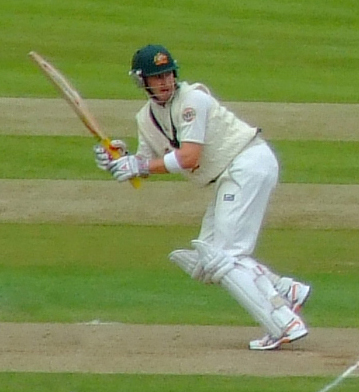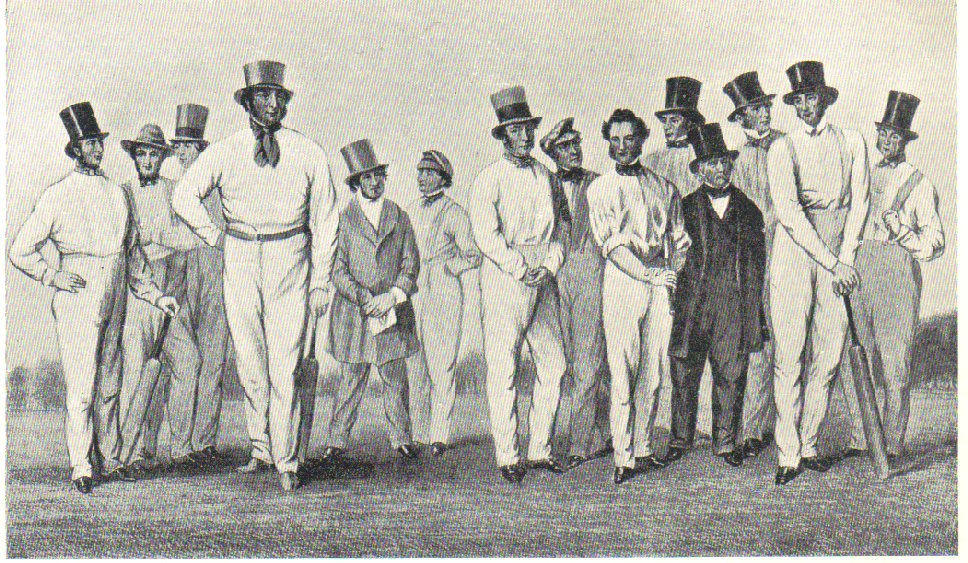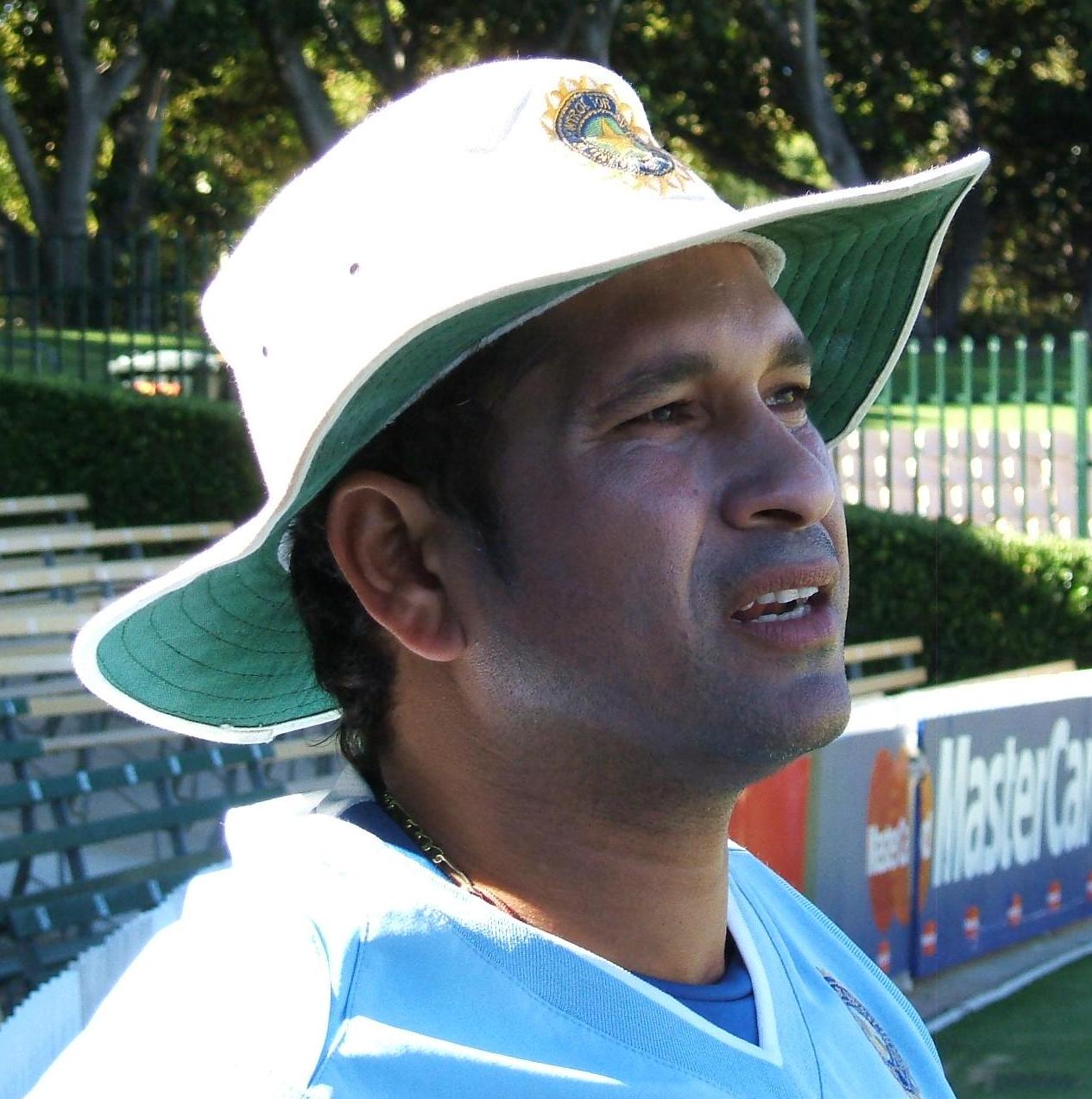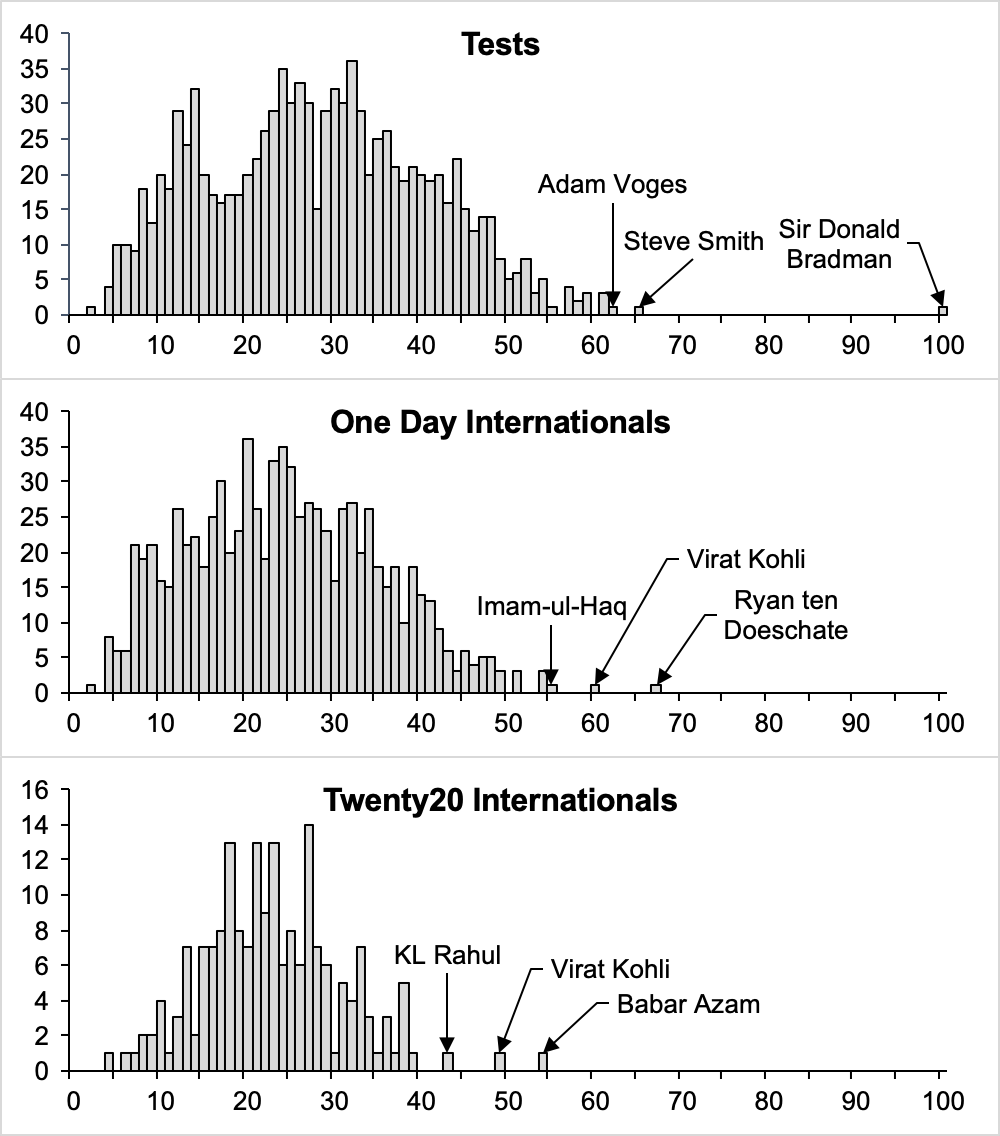|
Indian Cricket Team In Australia In 2011–12
The Indian cricket team toured Australia from 15 December 2011 to 28 February 2012. The tour included four Tests to contest the Border–Gavaskar Trophy (which was held by India at the start of the tour), two Twenty20s (T20Is), and eight ODIs as part of the Commonwealth Bank Tri-Series which also involved Sri Lanka. Australian won the four Test series in a 4–0 whitewash to regain the Border-Gavaskar Trophy. Australian captain Michael Clarke was named the player of the series, having scored 626 runs at an average of 125.20. In the second Test match, Clarke, with 329 not out, scored the 25th triple century in Test match cricket. The third Test match saw David Warner bring up a century in just 69 deliveries, setting a new record for the fastest Test century by an opening batsman. In the fourth Test, Ricky Ponting and Michael Clarke compiled a fourth wicket partnership of 386 runs, the highest partnership in Tests between Australia and India, or in Tests at the Adelaide Oval. Fo ... [...More Info...] [...Related Items...] OR: [Wikipedia] [Google] [Baidu] |
Michael Clarke (cricketer)
Michael John Clarke (born 2 April 1981) is an Australian former cricketer. He was captain of the Australian cricket team in both Test and One Day International (ODI) between 2011 and 2015, leading Australia to victory in the 2015 Cricket World Cup. He also served as captain of the Twenty20 International (T20I) side between 2007 and 2010. He is regarded as one of the best batsmen of his generation. Nicknamed "Pup", Clarke was a right-handed middle-order batsman, an occasional left-arm orthodox spin bowler and also a slip catcher. He represented New South Wales at a domestic level. Clarke retired from all forms of cricket after the final Test of the 2015 Ashes series. Early life Clarke was born and raised in Liverpool, New South Wales. He attended Marsden Road Public School and cultivated his batting skills at his father's indoor cricket centre in Liverpool after school. His junior club was the Western Suburbs District Cricket Club. Domestic career Clarke made his first-cl ... [...More Info...] [...Related Items...] OR: [Wikipedia] [Google] [Baidu] |
Border–Gavaskar Trophy
The Border–Gavaskar Trophy is a Test cricket series played between India and Australia. It is played via the International Cricket Council's future tours program, every two years. , India holds the trophy after defeating Australia in 2020-21 by two Tests to one, with one drawn match. If a series is drawn, the country holding the trophy retains it. The series is named after distinguished former captains, Australia's Allan Border and India's Sunil Gavaskar. In competition for the trophy since 1996, Indian Sachin Tendulkar has been the most successful batsman, scoring 3262 runs from 65 innings. Indian bowler Anil Kumble is the most successful bowler, taking 111 wickets over 20 matches at an average of 30.32. Background Before the Border–Gavaskar Trophy, India and Australia had played each other 50 times in Tests in a 49-year period from 1947 to 1996. Australia was the first country India toured soon after their Independence. However, during the period, the tours between both t ... [...More Info...] [...Related Items...] OR: [Wikipedia] [Google] [Baidu] |
England National Cricket Team
The England cricket team represents England and Wales in international cricket. Since 1997, it has been governed by the England and Wales Cricket Board (ECB), having been previously governed by Marylebone Cricket Club (the MCC) since 1903. England, as a founding nation, is a Full Member of the International Cricket Council (ICC) with Test, One Day International (ODI) and Twenty20 International (T20I) status. Until the 1990s, Scottish and Irish players also played for England as those countries were not yet ICC members in their own right. England and Australia were the first teams to play a Test match (15–19 March 1877), and along with South Africa, these nations formed the Imperial Cricket Conference (the predecessor to today's International Cricket Council) on 15 June 1909. England and Australia also played the first ODI on 5 January 1971. England's first T20I was played on 13 June 2005, once more against Australia. , England have played 1,058 Test matches, winning 387 and lo ... [...More Info...] [...Related Items...] OR: [Wikipedia] [Google] [Baidu] |
Indian Cricket Team In England In 2011
The Indian cricket team toured England from 21 July to 16 September 2011. The tour consisted of one Twenty20 International (T20I), five One Day Internationals (ODIs) and four Test matches, as well as a number of matches against English county sides. The opening Test at Lord's was the 2,000th Test. England's victory in the Third Test put them number one in the world rankings. Squads † Virat Kohli, Pragyan Ojha and RP Singh replaced the injured Yuvraj Singh, Harbhajan Singh and Zaheer Khan, respectively, for the third and fourth Test matches. ‡ Ravindra Jadeja replaced the injured Gautam Gambhir for the ODI series. Tour matches First-class: Somerset v Indians India rested a number of their Test players for their first match of the tour; Mahendra Singh Dhoni, Ishant Sharma, Praveen Kumar and Harbhajan Singh were all left out of the team. The weakened bowling attack showed on the first day of the match, when Somerset scored 329 for the loss of two wickets from a rain-reduced ... [...More Info...] [...Related Items...] OR: [Wikipedia] [Google] [Baidu] |
Batsman
In cricket, batting is the act or skill of hitting the ball with a bat to score runs and prevent the loss of one's wicket. Any player who is currently batting is, since September 2021, officially referred to as a batter (historically, the terms "batsman" and "batswoman" were used), regardless of whether batting is their particular area of expertise. Batters have to adapt to various conditions when playing on different cricket pitches, especially in different countries - therefore, as well as having outstanding physical batting skills, top-level batters will have quick reflexes, excellent decision-making and be good strategists. During an innings two members of the batting side are on the pitch at any time: the one facing the current delivery from the bowler is called the striker, while the other is the non-striker. When a batter is out, he is replaced by a team-mate. This continues until the end of the innings, which in most cases is when 10 of the team members are out, w ... [...More Info...] [...Related Items...] OR: [Wikipedia] [Google] [Baidu] |
Wicketkeeper
The wicket-keeper in the sport of cricket is the player on the fielding side who stands behind the wicket or stumps being watchful of the batsman and ready to take a catch, stump the batsman out and run out a batsman when occasion arises. The wicket-keeper is the only member of the fielding side permitted to wear gloves and external leg guards. The role of the keeper is governed by Law 27 of the Laws of Cricket. Stance Initially, during the bowling of the ball the wicket-keeper crouches in a full squatting position but partly stands up as the ball is received. Australian wicket-keeper Sammy Carter (1878 to 1948) was the first to squat on his haunches rather than bend over from the waist (stooping). Purposes The keeper's major function is to stop deliveries that pass the batsman (in order to prevent runs being scored as 'byes'), but he can also attempt to dismiss the batsman in various ways: * The most common dismissal effected by the keeper is for him to '' catch'' a ... [...More Info...] [...Related Items...] OR: [Wikipedia] [Google] [Baidu] |
Indian Cricket Team In South Africa In 2010-11
Indian or Indians may refer to: Peoples South Asia * Indian people, people of Indian nationality, or people who have an Indian ancestor ** Non-resident Indian, a citizen of India who has temporarily emigrated to another country * South Asian ethnic groups, referring to people of the Indian subcontinent, as well as the greater South Asia region prior to the 1947 partition of India * Anglo-Indians, people with mixed Indian and British ancestry, or people of British descent born or living in the Indian subcontinent * East Indians, a Christian community in India Europe * British Indians, British people of Indian origin The Americas * Indo-Canadians, Canadian people of Indian origin * Indian Americans, American people of Indian origin * Indigenous peoples of the Americas, the pre-Columbian inhabitants of the Americas and their descendants ** Plains Indians, the common name for the Native Americans who lived on the Great Plains of North America ** Native Americans in the Uni ... [...More Info...] [...Related Items...] OR: [Wikipedia] [Google] [Baidu] |
Indian Subcontinent
The Indian subcontinent is a list of the physiographic regions of the world, physiographical region in United Nations geoscheme for Asia#Southern Asia, Southern Asia. It is situated on the Indian Plate, projecting southwards into the Indian Ocean from the Himalayas. Geopolitically, it includes the countries of Bangladesh, Bhutan, India, Maldives, Nepal, Pakistan, and Sri Lanka."Indian subcontinent". ''Oxford Dictionary of English, New Oxford Dictionary of English'' () New York: Oxford University Press, 2001; p. 929: "the part of Asia south of the Himalayas which forms a peninsula extending into the Indian Ocean, between the Arabian Sea and the Bay of Bengal. Historically forming the whole territory of Greater India, the region is now divided into three countries named Bangladesh, India and Pakistan." The terms ''Indian subcontinent'' and ''South Asia'' are often used interchangeably to denote the region, although the geopolitical term of South Asia frequently includes Afghanist ... [...More Info...] [...Related Items...] OR: [Wikipedia] [Google] [Baidu] |
2011 Cricket World Cup
The 2011 ICC Cricket World Cup was the tenth Cricket World Cup. It was played in India, Sri Lanka, and for the first time in Bangladesh. India won the tournament, defeating Sri Lanka by 6 wickets in the final at Wankhede Stadium in Mumbai, thus becoming the first country to win the Cricket World Cup final on home soil. India's Yuvraj Singh was declared the man of the tournament. This was the first time in World Cup history that two Asian teams had appeared in the final. It was also the first time since the 1992 World Cup that the final match did not feature Australia. Fourteen national cricket teams took part in this tournament, including 10 full members and four associate members of the International Cricket Council (ICC). The opening ceremony was held on 17 February 2011 at Bangabandhu National Stadium, Dhaka, and the tournament was played between 19 February and 2 April. The first match was played between India and Bangladesh at the Sher-e-Bangla National Stadium in Mirp ... [...More Info...] [...Related Items...] OR: [Wikipedia] [Google] [Baidu] |
David Warner (cricketer)
David Andrew Warner (born 27 October 1986) is an Australian international cricketer and a List of Australia national cricket captains, former captain of the Australia national cricket team, Australian national team in limited overs format and a former Test vice-captain. A left-handed Batting order (cricket)#Opening batsmen or openers, opening batsman, Warner is the first Australian cricketer in 132 years to be selected for a national team in any format without experience in first-class cricket. He is considered as one of the best batters of the current era. He plays for New South Wales cricket team, New South Wales and played for the Sydney Thunder in domestic cricket. In January 2017, he became the fourth player to win the Allan Border Medal more than once and also win the award in consecutive years. Australian cricket team in India in 2017–18#4th ODI, On 28 September 2017, he played in his 100th ODI and became the first batsman for Australia and 8th batsman overall to score ... [...More Info...] [...Related Items...] OR: [Wikipedia] [Google] [Baidu] |
List Of Test Cricket Triple Centuries
A triple century (an individual score of 300 or more) in Test cricket has been scored on 31 occasions by 27 batsmen from eight of the twelve Test-cricket playing nations. No player from Afghanistan, Bangladesh, Ireland or Zimbabwe has scored 300. The frequency of a batsman scoring a Test triple century is slightly lower than that of a bowler taking a Test hat-trick (31 triple centuries versus 46 hat-tricks as of April 2022). History The first Test triple century was achieved by Andy Sandham of England against the West Indies in 1930 in the first Test series hosted in the West Indies. The quickest Test triple-century was scored in 4 hours 48 minutes, by Wally Hammond for England against New Zealand at Auckland in 1932–33. The fastest Test triple-century by number of balls faced, where that figure is recorded, is Virender Sehwag's 278-ball triple century for India against South Africa in the first Test of the Future Cup in Chennai in 2008. Donald Bradman (Australia), Brian Lar ... [...More Info...] [...Related Items...] OR: [Wikipedia] [Google] [Baidu] |
Batting Average (cricket)
In cricket, a player's batting average is the total number of runs they have scored divided by the number of times they have been out, usually given to two decimal places. Since the number of runs a player scores and how often they get out are primarily measures of their own playing ability, and largely independent of their teammates, batting average is a good metric for an individual player's skill as a batter (although the practice of drawing comparisons between players on this basis is not without criticism). The number is also simple to interpret intuitively. If all the batter's innings were completed (i.e. they were out every innings), this is the average number of runs they score per innings. If they did not complete all their innings (i.e. some innings they finished not out), this number is an estimate of the unknown average number of runs they score per innings. Each player normally has several batting averages, with a different figure calculated for each type of match ... [...More Info...] [...Related Items...] OR: [Wikipedia] [Google] [Baidu] |






.jpg)


